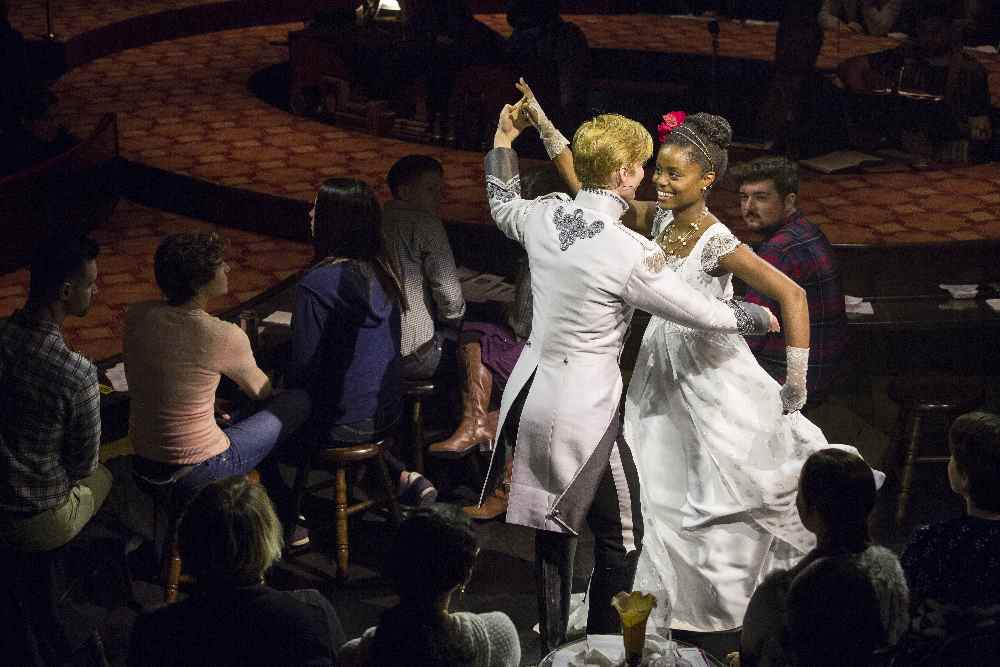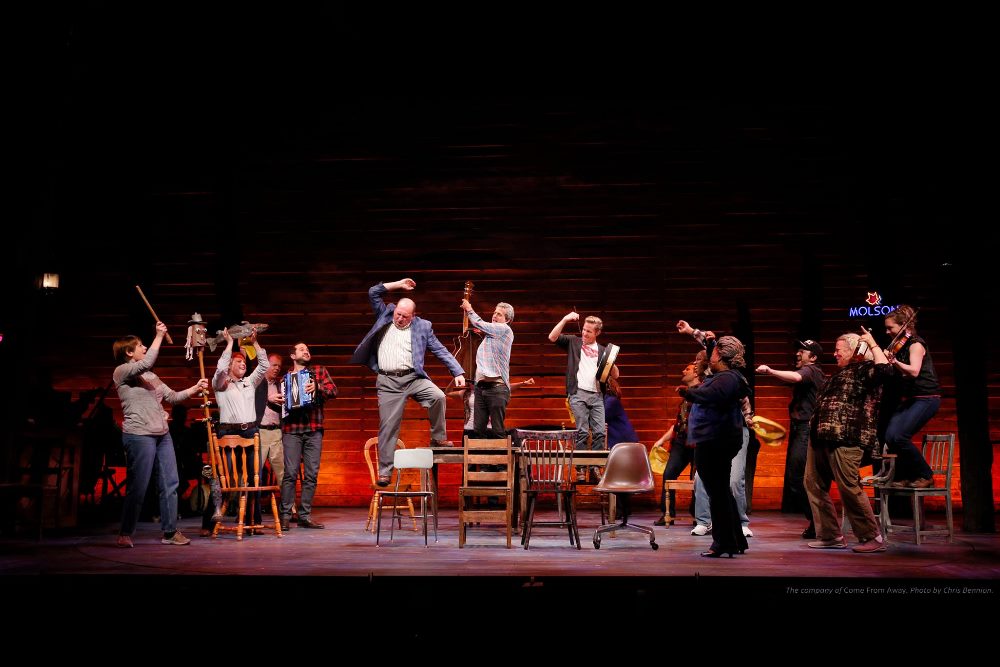Diversity was the central theme at the Tony Awards on June 12. Host James Corden pointed it out in his opening monologue: “Think of tonight as the Oscars, but with diversity. It’s so diverse, Donald Drumpf has threatened to build a wall around this theatre.”
Indeed, it ended up being a milestone of a night for people of color. Hamilton won 11 awards; the Tonys made history by giving the awards in all four of its musical acting categories to people of color; and the two designers of color who were nominated, Paul Tazewell and Clint Ramos, both won. And Spring Awakening performed, showcasing the power of deaf and disabled bodies onstage.
For the first time in #TonyAwards history, all four musical acting awards have gone to people of color.
— The Tony Awards (@TheTonyAwards) June 13, 2016
So we should all be rejoicing, right? After all, the underrepresented finally got their due!
Not so far. Despite the performances and the cheers, I can only manage tepid applause. I’m not so easily impressed. Because while this season was the most diverse season ever assembled on Broadway, next year’s season is already shaping up to look more like business as usual. As even Lin-Manuel Miranda admits, “I think our incredibly, amazingly diverse Tonys season that just ended was a fluke.”
A cursory glance at the Broadway productions announced to date for 2016-17 proves his statement. Of the 23 shows confirmed with theatres, two have all-black casts (Jitney and Motown), one has a mostly Asian cast (Miss Saigon), and two have multiracial casts (Natasha, Pierre & the Great Comet of 1812 and Gotta Dance). This doesn’t represent the whole season; 7 more shows have been announced but still await a theatre and their casting isn’t determined. By comparison, in 2015-16, a total of 39 shows opened on Broadway.
Besides the shows I just highlighted, casts haven’t been announced for a majority of the remaining shows. So who knows? There may be many actors of color or disabled actors in that remaining bunch of shows. But if past trends are any indication, those other shows are likely to have primarily white, able-bodied casts. According to the Asian American Performers Action Coalition, between 2006 and 2015, actors of color in New York City were cast 23 percent of the time, and within that number, an average of only 10 percent of the time without regard to race.
And that’s just the faces onstage. For all its visible diversity, the 2015-16 season included just 6 writers of color (including composers) out of 39 shows. Of the shows announced so far for next season, there are just two*: August Wilson (Jitney) and book writer Berry Gordy of Motown (which returns to Broadway after a national tour).
Not to mention that there seem to be no productions next year with entirely female creative teams, as there were this past season in the cases of Eclipsed and Waitress. Of the 30 announced shows, four will have female directors, all of them white: Josie Rourke of Les Liaisons Dangereuses, Rachel Chavkin of Natasha, Pierre & the Great Comet of 1812, Kathleen Marshall of In Transit, and Pam MacKinnon of Amélie.
This shouldn’t be such a great surprise. Though artists of color were recognized many times over at this year’s Tony Awards, historically speaking it was a small drop in the bucket. According to Forbes, since the Tony Awards began in 1947 it has recognized actors of color only 126 times (130 after this year’s ceremony)—that’s compared to 2,357 Caucasian winners.
In Pamela Newton’s American Theatre article about designers of color on Broadway, Tony winner Tazewell expressed similar misgivings: “History has proven that there’s a pendulum. The pendulum I think will start to widen, start to open up more possibilities, but it is bound to shift back because that is the nature of the beast.”

So what can we do now? How do we keep this momentum going?
Well first, diversity should not be a “fluke.” This past season, a large number of shows telling diverse stories and featuring diverse casts happened to get into a Broadway theatre at around the same time. But if diversity is going to become a mainstay on the Great White Way, producers and directors need to be intentional about it.
As a number of shows announced for next season haven’t yet confirmed their complete casts, producers have an historic opportunity. Now would be the time to find actors of color for lead roles and to fill out the casts of shows like Charlie and the Chocolate Factory, Come From Away, Hello, Dolly!, and Cats. They should be considered for roles in which the race of the character is not prescribed and which could be filled by anyone—in other words, most roles—and especially filled by actors who reflect the diversity of New York City, not to mention the nation at large.
One heartening move: Philippa Soo, Tony-nominated for her performance in Hamilton, will play the title role in Amélie. On the other hand, judging from the mostly white cast list of the world premiere production at Berkeley Repertory Theatre, I’m not betting on Hamilton-style demographics for that show. And one actor of color, even in the lead, does not equal diversity.
In an interview I did with Rachel Chavkin last year, she talked about why almost all of the shows she’s directed have a multiracial cast, even when set in Russia. “I do it on purpose, because it’s integral to the work being interesting,” she said. To her, the way you make a work “complicated and interesting is to have a complicated and diverse group of people involved in it.” The Natasha in the show, which is based on a portion of War and Peace, will be played by black actress Denée Benton (filling a role previously played by Soo).
So, though its leads have been announced (Janet McTeer, Liev Schreiber), there is no reason why the cast of the upcoming revival of Les Liaisons Dangereuses should be all-white. Producers, directors, and casting directors need to understand that in a world where we’ve accepted that a black men can be Aaron Burr and Thomas Jefferson (and get Tonys for playing them), the game has changed. By all rights Leslie Odom Jr., who played Burr, should be barraged with offers for meaty leading roles. He hasn’t been. Instead, as he told the Hollywood Reporter recently:
Imagine if a white actor were having a similar situation to what I’m having, with the kind of success of the show—there might be three or four offers a week for the next shows you’re going to do. There are no shows for me to do. There’s just no roles…. Unless we’re talking about somebody’s going to reimagine something, somebody’s going to let me do a She Loves Me or a Music Man. These are roles that were written for white actors.
Yes, those roles were originally played by white actors—but that doesn’t mean they always have to be. After all, this season Broadway also got its first Asian-American Christine in Phantom of the Opera and its first black Jean Valjean in Les Misérables. (If you’re wondering why it’s considered progressive to cast an actor of color in a traditionally white role but the reverse is regressive, read up.)
And it’s not just a matter of who’s telling and enacting the stories: It’s also what stories are being told. There is a reason why it took the collective action of Asian-American producers to get Allegiance to Broadway, as the first musical created and helmed by a mostly Asian creative team, telling a story that’s too often overlooked in American history classes. As George Takei told me last year, “This is the first time that we’ve had this [number] of Asian-Americans investing in theatrical production…We’ve gotten so many [people], particularly Japanese-American, to invest in this production. From Hawaii alone, we’ve gotten over $4 million.”
Black producer Stephen Byrd (who coproduced Eclipsed) told Forbes that he chooses to invest in shows with diverse casts, saying that for him and producing partner Alia Jones-Harvey, “We’ve gone to marketing meetings where we don’t see anyone in the office who looks like us. Our mandate when writing checks is: At least X people of color have to be hired.”

Then again, it’s early days yet for 2016-17, so perhaps I will be pleasantly surprised when the remaining shows and their casts are confirmed. Not to mention that some of this season’s diverse works will run into next season—certainly Hamilton and likely On Your Feet, Waitress, and The Color Purple.
What’s clear is that diversity will be a constant in our commercial theatre only when producers are intentional about the stories they choose to invest in. “The audience won’t buy it” can no longer be an excuse; clearly audiences are hungry for stories outside of the straight, white, middle-class experience, and from writers and performers of all backgrounds. Of course, Broadway shouldn’t be the end goal for all theatre artists, and what makes it to Broadway doesn’t get there overnight but represents larger trends at work in the American theatre, most often among nonprofit theatres. But for many it’s the rare opportunity to expose their work nationally, and to make something close to a living wage. It is also a powerful validation, a symbol of what the culture values and honors.
In my years of talking to playwrights and other theatre artists, I’ve come away with the consensus that while a world premiere is a large milestone, it doesn’t signify longevity. Instead, the mark of a play’s endurance isn’t its first production, but the second, third—and, if you’re Ayad Akhtar, the 18th. I feel the same about diversity on Broadway. I’m no longer satisfied with just having the first all-people-of-color or all-female creative team, the first all-black-and-female creative team, the first actress in a wheelchair on Broadway. Lea Salonga was the first Asian-American actress to win a Tony Award in 1991, and it took another 24 years for the second Asian-American actress to win a Tony.
So for me, the mark of true progress is no longer firsts. It’s the second; it’s the third. It’s whenever we stop needing to count. It’s effortless diversity that does not stand out, that is the norm and not the exception.
So for any producers and directors thinking of mounting a work next season, on Broadway or anywhere: Don’t cast your show with an all-white cast. Make diversity intentional, not accidental. Find stories you’ve never seen represented onstage before, from a group of people that rarely gets to speak. To quote Hamilton, “History has its eyes on you.” Which side of history will you be on?
*A previous version of this story erroneously labeled lyricist Kristen Anderson-Lopez (of the upcoming Broadway musical In Transit) as a writer of color. We’ve fixed it, with apologies.


